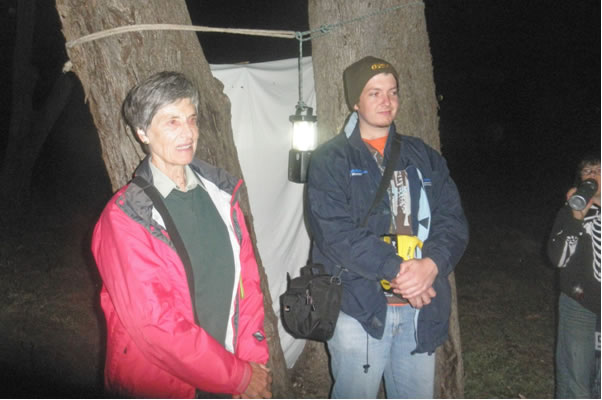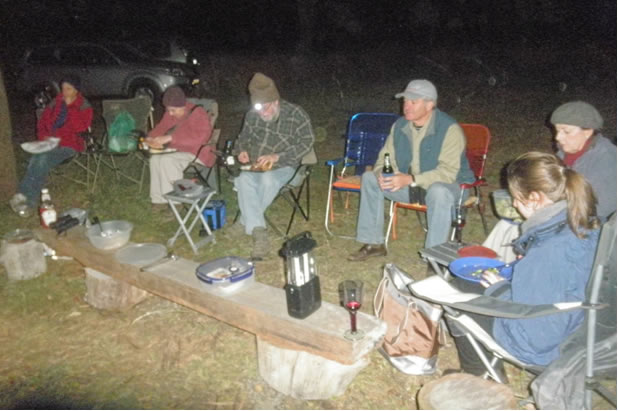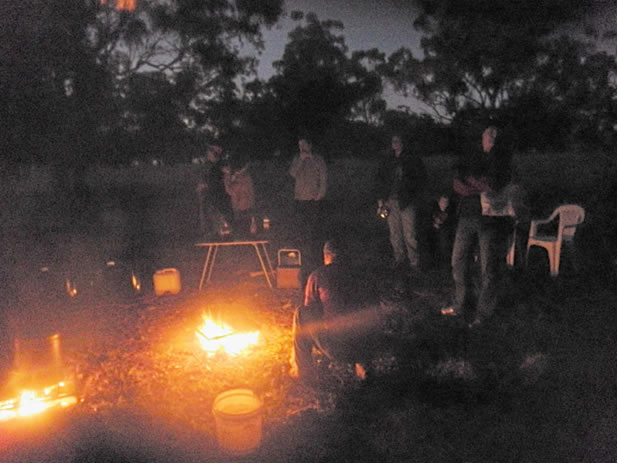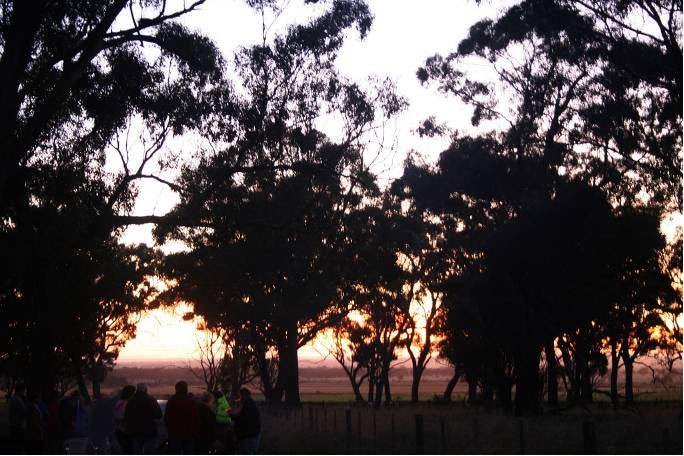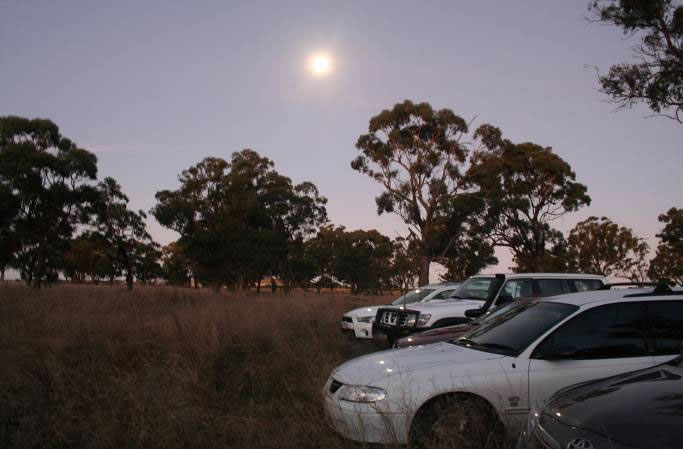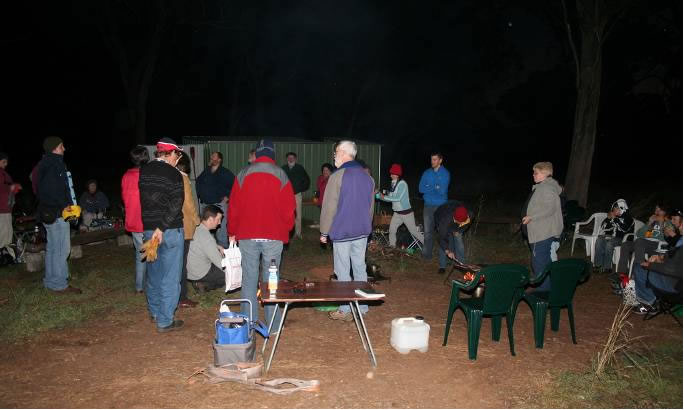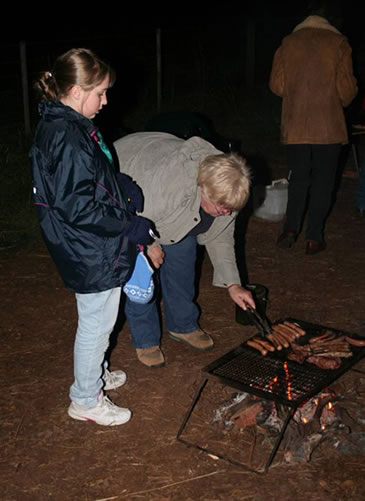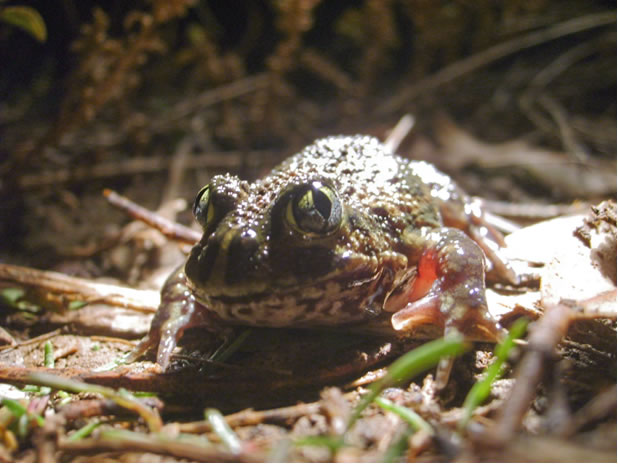Discovery of new frog species in Pinkerton Forest
On Saturday 16th April about thirty-eight people visited Pinkerton Forest for an evening family BBQ hosted by Pinkerton Landcare & Environment Group (PLEG) and Western Water.
|
These included members of Western Water, local environment groups such as Pinkerton Landcare & Environment Group, Friends of Toolern Creek, Friends of Melton Botanical Gardens, Australian Plant Society (Melton/Bacchus), Friends off Bullum Bullum (Caroline Springs) & from further afield Riddells Creek Landcare and Bird Observation & Conservation Australia (BOCA). A newly erected self composting toilet has been kindly supplied & erected at the site by Western Water. The BBQ was followed by several night walks. We hoped to see possums but they kept well out of our way. A few tiny bats could be seen among the treetops in the twilight before it became too dark to spot them against the darkening sky. A total of seven bat species were recorded in Pinkerton Forest in a recent Flora and Fauna Survey. Some visitors walked through the bush to see our two large eagle's nests, before darkness fell. During their nightwalk in the forest, the bird watching party from BOCA discovered a Barn Owl whose loud screeching calls could be heard throughout the forest. Later, as we were packing up, a Boobook Owl also made its presence known with its quite different but familiar ‘mopoke' call. Tim Hatt (Western Water's environmental officer) and his family set up a sheet between two trees in front of a bright lamp to attract moths and other nocturnal insects. There was a full moon shining brightly overhead, which added to the atmosphere of the walk in the bush but unfortunately the bright moonlight prevented us from attracting as many moths as we had hoped. Pinkerton is home to an impressive diversity of moths also. The wet conditions over the past year have resulted in large increases in moth numbers, especially large moths. Moths are an important food source for wildlife, including birds such owls and frogmouths, bats and other native mammals. There is a rich diversity of large moths commonly seen in this area including Emperor Gum Moths, Hawk Moths, Old Lady Moths and many others. We are all familiar with the large Cossid or Goat Moths that appear after rains. These large moths spend most of their lives underground, sometimes for many years (the familiar ‘witchetty' or ‘bardie grubs'). Fortunately Janet Dyke (of Friends of Melton Botanic Gardens) had brought along a large Hawk Moth she found on her window that day to show us, as an example of the moths to be found in this region. Last year Marilyn Hewish, a member of the Victorian Entomological Society, and a leading authority on moths, discovered a rich variety of moths during a survey in Pinkerton. Moths, as well as other insects, are an important part of the woodland ecosystem. As well as providing food for other wildlife they also perform a valuable function in breaking down plant material and debris, and returning it to the soil. Leaf-eating caterpillars and moths, as well as other insects, create a constant rain of droppings from the trees to the ground. Other insects feed similarly on terrestrial plants and leaf litter, returning this plant matter to the soil also; especially those insects that feed on leaf litter. They therefore ensure that plant matter and leaf litter does not build up on the ground to the extent that one would expect. By constantly breaking down this material they not only return the matter to the soil but also reduce the risk of bushfire by reducing the level of fuel on the woodland floor. PLEG member Richard Akers led us on a walk to a large dam on the edge of Pinkerton Forest where he identified to us the clicking calls of numerous Spotted Marsh Frogs. This dam forms a valuable wetland that attracts large numbers of waterbirds. The dam is primarily for use in watering the surrounding grazing land but it is invaluable in proving waterbirds with a refuge in times of drought, and a resting place for migrating birds, as well as adding to the biodiversity of Pinkerton Forest. This wetland amply demonstrates that pastoral land use need not be incompatible with wildlife conservation. An exciting discovery was made when Richard brought to our attention the calls of a Spadefoot Toad calling from the darkness. These burrowing frogs (not actually toads) burrow into the ground using a distinctive small black ‘spade' on their hind feet. They burrow into the ground (like the better known Pobblebonk frog) to escape drought. These frogs have not been identified in Pinkerton before. In the Melton region they have previously been identified in a few localities in Melton and Melton South. In the greater Melbourne region they have so far been discovered in Melton, Sunbury & Pattersons Lakes only. Pinkerton Forest is now one of a few select sites in the Melbourne region where these uncommon frogs have been found. So, despite the informal nature of this evening, we made the discovery of a new frog species here, adding to the rich wildlife diversity of Pinkerton Forest and its surrounds. We now know there are four frog species in Pinkerton (now including the newly discovered Spadefoot Toad). Over 130 bird species have been identified at Pinkerton by BOCA members who conduct regular quarterly bird surveys here. The evening was a great success with all present enjoying the both night BBQ and the moonlight walk in the forest. |
members of Bird Observation & Conservation Australia
BBQ in the dark at Pinkerton
Sunset at Pinkerton by Bill Strong
Moonlight at Pinkerton by Bill Strong
BBQ by the new shed by Bill Strong
Sonja & Pam by Bill Strong
Spadefoot Toad photographed in Melton South by Richard Akers
Moth photographed in Pinkerton in 2010 by Richard Akers
|

